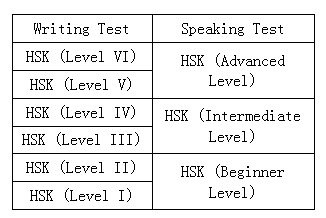According to The Administrative Measures on The Recruitment and Training of International Students by Schools (Order No. 42) and The Administrative Provisions on The Recruitment and Training of International Students by Schools in Hebei Province, International students who receive Bachelor degrees or advanced degrees with teaching language not in Chinese must obtain the certificate of Chinese proficiency test (HSK) level 4 or above before graduation from colleges or universities. So here is a brief introduction to HSK.
The HSK test was launched by Hanban in an effort to better serve Chinese language learners. The test is the result of coordinated efforts by experts from different disciplines including Chinese language teaching, linguistics, psychology and educational measurement. The new exam combines the advantages of the original HSK while taking into consideration recent trends in Chinese language training by conducting surveys and making use of the latest findings in international language testing.
I. Test Structure
The new HSK is an international standardized exam that tests and rates Chinese language proficiency. It assesses non-native Chinese speakers’ abilities in using the Chinese language in their daily, academic and professional lives. The new HSK consists of a writing test and a speaking test, which are independent of each other. There are six levels of writing tests, namely the HSK (level I), HSK (level II), HSK (level III), HSK (level IV), HSK (level V), and HSK (level VI). There are three levels of speaking tests, namely the HSK (beginner level), HSK (intermediate level), and HSK (advanced level). During the speaking test, test takers’ speeches will be recorded.

II. Test Levels
The different levels of the new HSK are similar to some of the levels in the Chinese Language Proficiency Scales for Speakers of Other Languages (CLPS) and the Common European Framework of Reference (CEF); details are as follows:

Test takers who are able to pass the HSK (Level I) can understand and use very simple Chinese phrases, meet basic needs for communication and possess the ability to further their Chinese language studies.
Test takers who are able to pass the HSK (Level II) have an excellent grasp of basic Chinese and can communicate in simple and routine tasks requiring a simple and direct exchange of information on familiar and routine matters.
Test takers who are able to pass the HSK (Level III) can communicate in Chinese at a basic level in their daily, academic and professional lives. They can manage most communication in Chinese when travelling in China.
Test takers who are able to pass the HSK (Level IV) can converse in Chinese on a wide range of topics and are able to communicate fluently with native Chinese speakers.
Test takers who are able to pass the HSK (Level V) can read Chinese newspapers and magazines, enjoy Chinese films and plays, and give a full-length speech in Chinese.
Test takers who are able to pass the HSK (Level VI) can easily comprehend written and spoken information in Chinese and can effectively express themselves in Chinese, both orally and on paper.
III. Test Form
1. Paper-based Test
2. Internet-based Test
The Internet-based Test is based on the Internet and the computer implementation examination, examines the examinee to use Chinese to carry on the communication ability. The content, standard and effectiveness of the test are the same as the paper-based. Online examination for HSK is convenient, flexible, economical, efficient, safe and stable, and supports online examination management, online payment and online simulation.
IV. Testing Purposes
The new HSK retains the former HSK’s orientation as a general (or universal) Chinese language abilities test for adult learners. The results of the test can serve several purposes:
1. A reference for an educational institution’s decision-making concerning recruiting students, assigning students to different classes, allowing students to skip certain courses and giving students academic credits.
2. A reference for employers’ decision-making concerning the recruitment, training and promotion of test takers.
3. A method for Chinese language learners to assess and improve their proficiency in Chinese.
4. A method for Chinese language training institutions to evaluate training results.
V. Results Certificate
Test takers will receive the results for the new HSK issued by Hanban within three weeks after the test.
VI. Registration Website
www.chinesetest.cn

